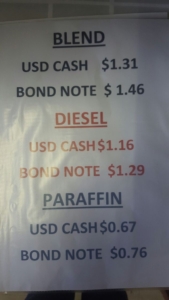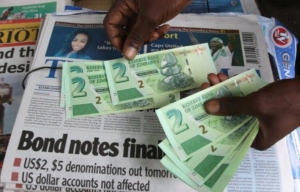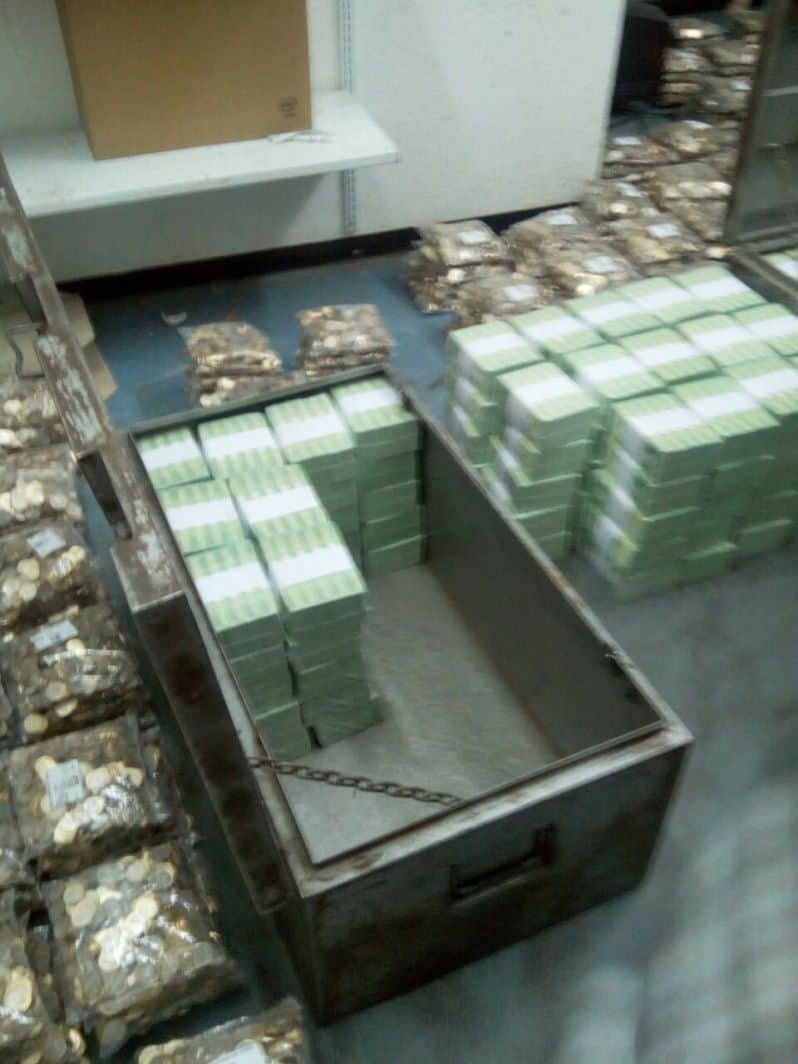Zimbabwe’s new money: This site(zimnes.net) has been running a number of reports on the new money from different experts and below is another detailed analysis of the new money (Zim Bond Notes).
Just What is a Bond Note
This is an enormous advantage for the States, it means that their own borrowings are in their own currency, they are the producer and supplier of dollar notes to the whole world and the huge profits made by turning bits of paper into real money with value, accrues to the US Treasury via the Federal Reserve – perhaps the most profitable enterprise in the world. It also means that whenever they want to they can simply turn on the printing presses (both real and electronic) and create billions of dollars to flood their domestic and international markets as they recently did during the process of recovery from the economic collapse of a decade ago. They did this without stimulating inflation in the States and without damaging the reputation of the currency as a safe haven for value.
Many have tried to replace the mighty dollar as an international reserve currency, but have failed – the most recent challenger being the Yuan – the currency of China; it did not even get out of the gates.

Many have argued since we adopted the USD among a number of currencies as our own means of exchange that this was a tactical error in that we are surrounded by countries with currencies that are depreciating against the dollar. Therefore, we are uncompetitive. There is some truth in that but we have very short memories – when I started work I earned local dollars – worth at the time nearly 3 US dollars. When we gained our Independence in 1980, the local dollar was still trading at 2 to 1 against the greenback and we were not only competitive but were exporting a wide range of goods and commodities to the world. So a “strong” currency is not necessarily a weakness or a problem.
The fact that the Asia Tigers have all used a manipulated exchange rate (artificially low) for their own currencies by buying USD with their own currency on open markets, as a means of stimulating growth and penetrating foreign markets is another matter. In fact one of the unexpected outcomes of such practices has meant that the Asian Tiger economies have built up huge surpluses of USD which they use as collateral for foreign borrowings on a vast scale – the numbers are staggering, China is the most indebted country in the world with over $250 trillion in borrowings. China’s rapid rise in the world as a manufacturing giant is built on the back of the USD and almost unlimited, low interest borrowings from the older economies with accrued savings.
When the Zanu PF regime in Harare began running an unsustainable budget deficit (it averaged 9 per cent for 20 years) and then began simply printing money to cover a burgeoning deficit from 2000 to 2008, the result was inevitable as any economist or banker will tell you – the currency crashed, all savings were wiped out, every bank and financial institution was pushed into technical liquidation.
So why has Obama been able to use quantitative easing – a euphemism for simply printing money on a massive scale and get away with it and not Robert Gabriel Mugabe? The answer is in two parts – firstly he was not using the Federal Reserve to fund a massive budget deficit – he was spending tax dollars and the Federal Reserve – a tough, independent institution, was controlling the money supply and watching the fundamentals. The US budget deficit was never allowed to spin out of control.
The second reason is more complex – the world of business and global consumers trust the US system. The United States is still one of the most under borrowed economies in the world – as measured by debt against output, and the macroeconomic fundamentals in the States are managed by strong independent institutions that do not allow politicians (even the President) to break the rules. US business has shown steady improvement in productivity for over a century and US workers are amongst the most productive and innovative in the world. Although US average incomes at $52 000 a year for every man, woman and child – are among of the highest in the world, their actual pay rates in real terms have been static for half a century.

Our problems are due to more fundamental issues – we are very heavily taxed and our kleptocratic government steals 14 per cent of our GDP equal to another half of all tax revenues – an impossible burden. Then they spend more than they are earning and to fund this they have to drain out of the economy whatever surpluses are being generated. To understand this you have to understand what they have been doing since they took over the Ministry of Finance and the Reserve Bank in August 2013. This is illustrated in the following table:
| Year | 2013 | 2014 | 2015 | 2016 | |
| Factor | US$ billions | US$ billions | US$ billions | US$ billions | |
| Bank Deposits | 4,5 | 4,8 | 5,2 | 6,1 | |
| Budget Deficit | 0,5 | 1,0 | 1,0 | 1,0 | |
| Treasury Bills | 1,5 | 2,5 | 3,5 | 4,3 | |
| Gov Overdraft | 0 | 0 | 0 | 1,1 | |
| Export Proceeds | 0 | 0 | 0 | 1,4 | |
| Bond Notes | 0 | 0 | 0 | 0,5 | |
| Cash in the Banks | 2,5 | 1,3 | O,7 | -2,3 | |
| Daily cash limits | NIL | NIL | 10 000 | 100 | |
What this table shows is that after the GNU when we ran a balanced budget for four years and did not allow the Reserve Bank to conduct any fiscal activities, savings, as represented by the cash balances held by Zimbabweans with the Commercial Banks grew from perhaps US$250 million in 2009 to US$4,5 billion in 2013. Half of which was in turn loaned out to the private sector for productive purposes. This left $2,5 billion in the banks to meet local demands for cash and trading payments. This was quite adequate as we were able as individuals to withdraw any amount of cash from our accounts on a daily basis.
You can see from these estimates (mine) that the available cash in the banks rapidly declines – despite rising savings, as the budget deficit absorbs more and more of the Banks liquidity. Despite this they remain in surplus until 2015, when the situation became so serious that the Reserve Bank had to impose withdrawal restrictions of US$10 000 a day. It is in 2016 that the situation deteriorates rapidly and out of control.
In response, on the 4th May 2016, the Government announces that it is to issue a new local currency called the “Bond Notes”. On Monday – the 28th November, the first Bond Notes appeared. The same size as the US dollar notes for counting machine purposes and only in $2 denominations.
Now just what are they? Well clearly they are a new form of local currency and it is clearly shown on each note that they are being issued by the Reserve Bank at par with the USD – interesting as the local banks will have had to buy these notes from the Reserve Bank in USD from the accounts of their depositors. Bearing in mind that the cost of a $2 bill will be a fraction of that sum, this is a very nice new stream of revenue for the Bank. None of the $2,5 million they have spent on advertising the new currency in a desperate effort to gain acceptance, says this though.
In the Courts where a battle is being waged to stop the new currency, the dialogue has raged to and fro – the latest version of the State’s case that I have seen is that the new notes are NOT a currency but a Promissory Note. Legally that is an interesting argument as a Promissory Note is essentially an IOU. It should be time bound and have the signature of the person issuing the note (done) and the person taking over the note (not done). Clearly this is nonsense and it shows how much the regime is at sixes and sevens on this issue. The first defense I saw was even more ridiculous.
But in reality the Bond Note is simply yet another extension of a massive scheme which is systematically stripping out the entire savings and surpluses of the country. When they issued Treasury Bills they were converting real money into worthless paper – worthless because the underwriter is broke and simply cannot under any circumstances be expected to either redeem the Bills at Par plus interest. This exercise was then extended to a massive overdraft to the State by the Reserve Bank – not using their own resources but private funds “borrowed” illegally from Nostro accounts held by the Bank on behalf of the private Banks. This overdraft is unsecured, carries no interest and can never be paid back by the borrower. As a consequence the RTGS system which was working so well in 2015, has virtually collapsed with some transfers 5 months in arrears.
As if that was not bad enough they are now taking US$200 a month, US$2,4 billion a year, from exporters and replacing it with electronic transfers of phantom money. The use of this form of money as an “export bonus” is laughable and completely undermines the viability of every exporter who now has to go cap in hand and bribe at the ready to get his own money (real money) from the Reserve Bank.
Bond Notes – whatever you call them, are just another extension of the scam this regime has been running since 2013. However, it is both an accelerator (will make matters in the market much worse) and an initiator of potentially very damaging public violence. Already the markets are discounting the new currency and this discount can only grow. As it does and the Banks are unable to pay out their customers in real money in any sort of quantum (at the moment it is about US$80 million a month across the whole economy) and fall back on the use of this new currency – issuing at par with the client only able to recover a small part of its face value in the real market, all hell will break loose.
Perhaps that is the intention.













